Lesson 24: Using Mail Merge
/en/word2010/using-a-template/content/
Introduction
Mail Merge is a useful tool that will allow you to easily produce multiple letters, labels, envelopes, nametags, and more using information stored in a list, database, or spreadsheet. In this lesson, you will learn how to use the Mail Merge Wizard to create a data source and a form letter, and you'll explore other wizard features.
Mail Merge
When you are performing a Mail Merge, you will need a Word document (you can start with an existing one or create a new one) and a recipient list, which is typically an Excel workbook.
If you'd like to work along with the lesson, you can download the examples below.
To use Mail Merge:
- Open an existing Word document, or create a new one.
- Click the Mailings tab.
- Click the Start Mail Merge command.
- Select Step by Step Mail Merge Wizard.
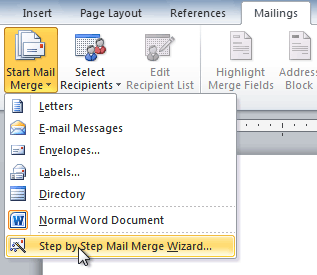 Selecting Step by Step Mail Merge Wizard
Selecting Step by Step Mail Merge Wizard
The Mail Merge task pane appears and will guide you through the six main steps to complete a merge. The following is an example of how to create a form letter and merge the letter with a recipient list.
Step 1:
- Choose the type of document you want to create. In this example, select Letters.
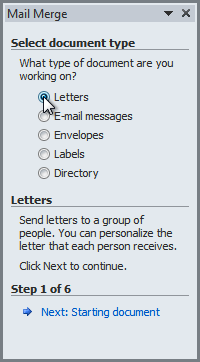 Selecting a document type
Selecting a document type - Click Next: Starting document to move to Step 2.
Step 2:
- Select Use the current document.
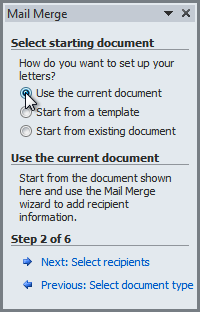 Selecting a starting document
Selecting a starting document - Click Next: Select recipients to move to Step 3.
Step 3:
Now you'll need an address list so Word can automatically place each address into the document. The list can be in an existing file, such as an Excel workbook, or you can type a new address list from within the Mail Merge Wizard.
- From the Mail Merge task pane, select Use an existing list, then click Browse.
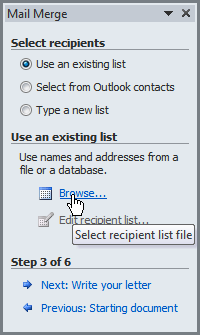 Browsing for a data source
Browsing for a data source - Locate your file in the dialog box (you may have to navigate to a different folder), then click Open.
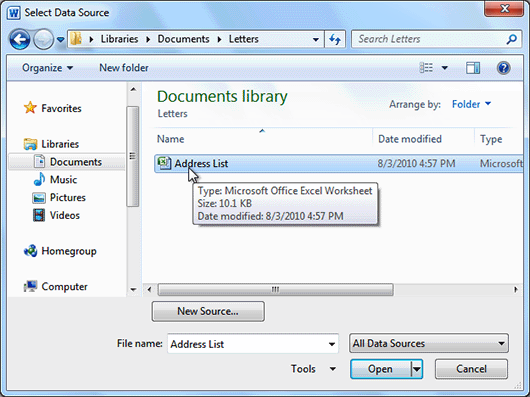 Choosing a file
Choosing a file - If the address list is in an Excel workbook, select the worksheet that contains the list, then click OK.
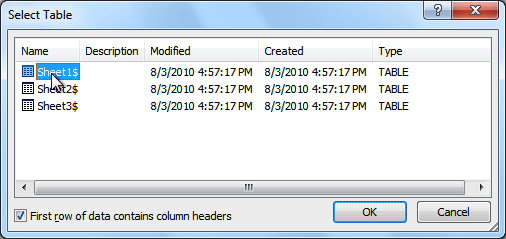 Selecting a table
Selecting a table - In the Mail Merge Recipients dialog box, you can check or uncheck each recipient to control which ones are used in the merge. When you're done, click OK to close the dialog box.
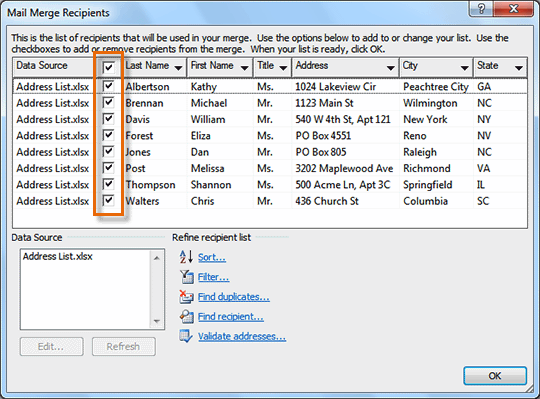 Use check boxes to include or exclude recipients
Use check boxes to include or exclude recipients - From the Mail Merge task pane, click Next: Write your letter to move to Step 4.
Step 4:
Now you're ready to write your letter. When it's printed, each copy of the letter will basically be the same, except the recipient data—like the name and address—will be different on each one. You'll need to add placeholders for the recipient data so Mail Merge knows exactly where to add the data. If you're using Mail Merge with an existing letter, make sure the file is open.
To insert recipient data:
- Place the insertion point in the document where you want the information to appear.
- Select Address block, Greeting line, Electronic postage, or More items from the task pane.
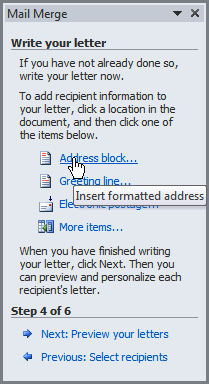 Inserting an address block
Inserting an address block - Depending on your selection, a dialog box may appear with various options. Select the desired options, then click OK.
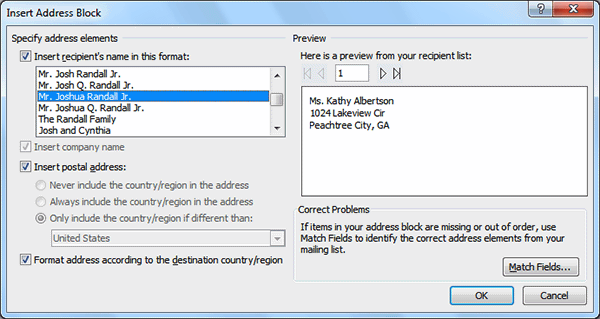 Adjusting the address block formatting
Adjusting the address block formatting - A placeholder appears in your document (for example: «AddressBlock»).
- Repeat these steps each time you need to enter information from your data record.
- From the Mail Merge task pane, click Next: Preview your letters to move to Step 5.
For some letters, you'll only need to add an Address block and Greeting line. Sometimes, however, you may want to place recipient data within the body of the letter to further personalize it.
Step 5:
- Preview the letters to make sure information from the recipient list appears correctly in the letter. You can use the left and right scroll arrows to view each document.
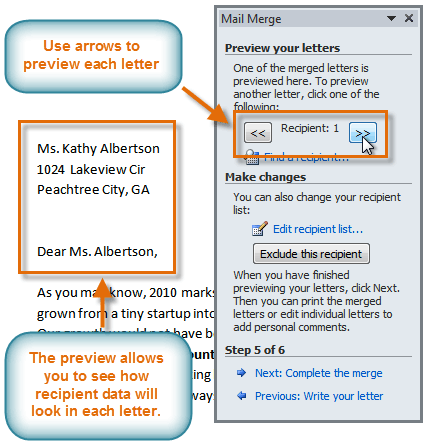 Previewing the letters
Previewing the letters - Click Next: Complete the merge to move to Step 6.
Step 6:
- Click Print to print the letters.
 Printing the letters
Printing the letters - The Merge to Printer dialog box opens. Click All, then click OK.
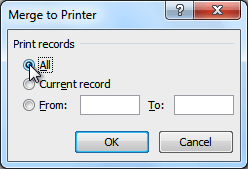 The Merge to Printer dialog box
The Merge to Printer dialog box - The Print dialog box will appear. Adjust the print settings if needed, then click OK.
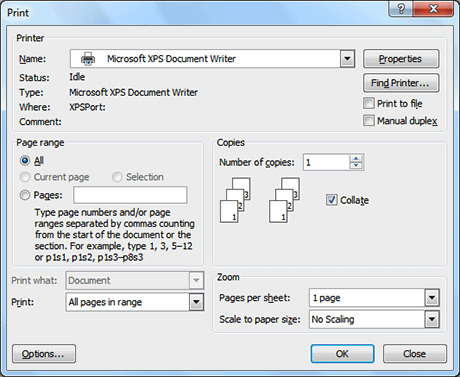 The Print dialog box
The Print dialog box
Challenge!
- Open an existing Word document. If you want, you can use this example.
- Download the recipient list.
- Use the Mail Merge Wizard to merge the letter with the recipient list.
- Place an Address Block at the top of the page and a Greeting line above the body of the letter.
- Print the document.
/en/word2010/4-free-alternatives-to-microsoft-office/content/


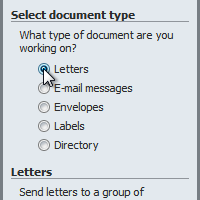
 Selecting Step by Step Mail Merge Wizard
Selecting Step by Step Mail Merge Wizard Selecting a document type
Selecting a document type Selecting a starting document
Selecting a starting document Browsing for a data source
Browsing for a data source Choosing a file
Choosing a file Selecting a table
Selecting a table Use check boxes to include or exclude recipients
Use check boxes to include or exclude recipients Inserting an address block
Inserting an address block Adjusting the address block formatting
Adjusting the address block formatting Previewing the letters
Previewing the letters Printing the letters
Printing the letters The Merge to Printer dialog box
The Merge to Printer dialog box The Print dialog box
The Print dialog box